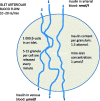Pancreatic islet blood flow and its measurement
- PMID: 27124642
- PMCID: PMC4900068
- DOI: 10.3109/03009734.2016.1164769
Pancreatic islet blood flow and its measurement
Abstract
Pancreatic islets are richly vascularized, and islet blood vessels are uniquely adapted to maintain and support the internal milieu of the islets favoring normal endocrine function. Islet blood flow is normally very high compared with that to the exocrine pancreas and is autonomously regulated through complex interactions between the nervous system, metabolites from insulin secreting β-cells, endothelium-derived mediators, and hormones. The islet blood flow is normally coupled to the needs for insulin release and is usually disturbed during glucose intolerance and overt diabetes. The present review provides a brief background on islet vascular function and especially focuses on available techniques to measure islet blood perfusion. The gold standard for islet blood flow measurements in experimental animals is the microsphere technique, and its advantages and disadvantages will be discussed. In humans there are still no methods to measure islet blood flow selectively, but new developments in radiological techniques hold great hopes for the future.
Keywords: Blood flow measurements; islet blood flow; microspheres; pancreatic islets.
Figures




References
-
- Hellerström C, Westman S, Zachrisson U, Hellman B.. The number of red blood cells in the islets of Langerhans as an index of the B cell activity. Acta Endocrinol (Copenh). 1960;34:611–18. - PubMed
-
- In't Veld P, Marichal M.. Microscopic anatomy of the human islet of Langerhans. Adv Exp Med Biol. 2010;654:1–19. - PubMed
-
- Henderson JR. Why are the islets of Langerhans? Lancet. 1969:469–70. - PubMed
-
- Persson-Sjögren S, Forsgren S, Täljedal IB.. Peptides and other neuronal markers in transplanted pancreatic islets. Peptides. 2000;21:741–52. - PubMed
Publication types
MeSH terms
Substances
LinkOut - more resources
Full Text Sources
Other Literature Sources
